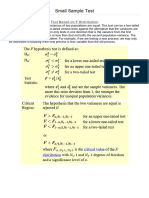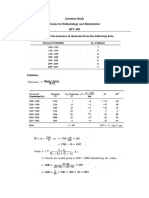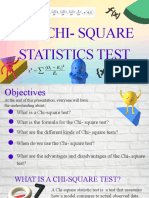Chi-Square Test
Uploaded by
Towhid HasanCopyright:
Available Formats
Chi-Square Test
Uploaded by
Towhid HasanCopyright
Available Formats
Share this document
Did you find this document useful?
Is this content inappropriate?
Copyright:
Available Formats
Chi-Square Test
Uploaded by
Towhid HasanCopyright:
Available Formats
Chi-Square Test of Independence
Search
Stat Trek Teach yourself statistics
Skip to main content
Home
Tutorials
AP Statistics
Stat Tables
Stat Tools
Calculators
Books
Help
Overview
AP statistics
Statistics and probability
Matrix algebra
Share with Friends
Chi-Square Test for Independence
This lesson explains how to conduct a chi-square test for independence.
The test is applied when you have two
categorical variables
from a single population. It is used to determine whether
there is a significant association between
the two variables.
For example, in an election survey, voters might be classified
by gender (male or female) and voting preference
(Democrat, Republican, or Independent). We could use a chi-square test for
independence to determine whether gender
is related to voting preference. The sample problem at the end of the lesson
considers this example.
When to Use Chi-Square Test for Independence
The test procedure described in this lesson is appropriate when the following conditions are met:
The sampling method is simple random sampling.
The variables under study are each categorical.
If sample data are displayed in a contingency table,
the expected frequency count for each cell of the table is
at
least 5.
This approach consists of four steps: (1) state the hypotheses, (2) formulate an analysis plan, (3) analyze sample data,
and (4) interpret results.
http://stattrek.com/chi-square-test/independence.aspx?Tutorial=AP[24-Apr-16 10:59:41 PM]
Chi-Square Test of Independence
State the Hypotheses
Suppose that Variable A has r levels, and Variable B has c levels.
The null hypothesis states that knowing the level of
Variable A does not help you predict the level of Variable B. That is, the variables are independent.
H0: Variable A and Variable B are independent.
Ha: Variable A and Variable B are not
independent.
The alternative hypothesis is that knowing the level of Variable A can help you predict the level of Variable B.
Note: Support for the alternative hypothesis suggests that the variables
are related; but the relationship is not necessarily
causal, in
the sense that one variable "causes" the other.
Formulate an Analysis Plan
The analysis plan describes how to use sample data to accept or reject the null hypothesis. The plan should specify the
following elements.
Significance level. Often, researchers choose significance levels
equal to 0.01, 0.05, or 0.10; but any value
between 0 and 1 can be used.
Test method. Use the chi-square test for independence
to determine whether there is a significant relationship
between two categorical variables.
Analyze Sample Data
Using sample data, find the degrees of freedom, expected frequencies, test statistic, and the P-value associated with the
test statistic.
The approach described in this section is illustrated in the sample problem at the end of this lesson.
Degrees of freedom. The degrees of freedom (DF) is equal to:
DF = (r - 1) * (c - 1)
where r is the number of levels for one catagorical variable, and c is the number of levels for the other categorical
variable.
Expected frequencies. The expected frequency counts
are computed separately for each level of one categorical
variable at each level of the other categorical variable. Compute r * c expected frequencies, according to the
following formula.
Er,c = (nr * nc) / n
where Er,c is the expected frequency count for level r of Variable A and
level c of Variable B, nr is the total
number of sample observations at level r of Variable A, nc is the total number of sample observations at level c of
Variable B, and n is the total sample size.
Test statistic. The test statistic is a chi-square random variable
(2) defined by
the following equation.
2 = [ (Or,c - Er,c)2 / Er,c ]
http://stattrek.com/chi-square-test/independence.aspx?Tutorial=AP[24-Apr-16 10:59:41 PM]
Chi-Square Test of Independence
where Or,c is the observed frequency count at level r of Variable A and level c of Variable B, and
Er,c is the
expected frequency count at level r of Variable A and level c of Variable B.
P-value. The P-value is the probability of observing a sample statistic as extreme as the test statistic. Since the
test statistic is a chi-square, use the Chi-Square Distribution Calculator
to assess the probability associated with
the test statistic. Use the degrees of freedom computed above.
Interpret Results
If the sample findings are unlikely, given
the null hypothesis, the researcher rejects the null hypothesis.
Typically, this
involves comparing the P-value to the significance level,
and rejecting the null hypothesis when the P-value is less than
the significance level.
Test Your Understanding
Problem
A public opinion poll surveyed a simple random sample of 1000 voters.
Respondents were classified by gender (male or
female) and by voting preference (Republican, Democrat, or Independent).
Results are shown in the
contingency table
below.
Voting Preferences
Row total
Republican Democrat Independent
Male
200
150
50
400
Female
250
300
50
600
Column total 450
450
100
1000
Is there a gender gap? Do the men's voting preferences differ
significantly from the women's preferences? Use a 0.05
level of significance.
Solution
The solution to this problem takes four steps: (1) state the hypotheses, (2) formulate an analysis plan, (3) analyze sample
data, and (4) interpret results. We work through those steps below:
State the hypotheses. The first step is to state the null hypothesis and an alternative hypothesis.
H0: Gender and voting preferences are independent.
Ha: Gender and voting preferences are not
independent.
Formulate an analysis plan. For this analysis,
the significance level is 0.05. Using sample data, we will conduct
a chi-square test for independence.
Analyze sample data. Applying the chi-square
test for independence to sample data, we compute the degrees of
freedom, the expected frequency counts, and
the chi-square test statistic. Based on the
chi-square statistic and the
degrees of freedom, we determine the
P-value.
DF = (r - 1) * (c - 1) = (2 - 1) * (3 - 1) = 2
Er,c = (nr * nc) / n
E1,1 = (400 * 450) / 1000 = 180000/1000 = 180
http://stattrek.com/chi-square-test/independence.aspx?Tutorial=AP[24-Apr-16 10:59:41 PM]
Chi-Square Test of Independence
E1,2 = (400 * 450) / 1000 = 180000/1000 = 180
E1,3 = (400 * 100) / 1000 = 40000/1000 = 40
E2,1 = (600 * 450) / 1000 = 270000/1000 = 270
E2,2 = (600 * 450) / 1000 = 270000/1000 = 270
E2,3 = (600 * 100) / 1000 = 60000/1000 = 60
2 = [ (Or,c - Er,c)2 / Er,c ]
2 = (200 - 180)2/180 + (150 - 180)2/180 + (50 - 40)2/40
+
(250 - 270)2/270 + (300 - 270)2/270 + (50 - 60)2/60
2 =
400/180 + 900/180 +
100/40 + 400/270 +
900/270 + 100/60
2 = 2.22 + 5.00 + 2.50 + 1.48 + 3.33 + 1.67 = 16.2
where DF is the degrees of freedom, r is the number of levels of gender, c is the number of levels of the voting
preference,
nr is the number of observations from level r
of gender,
nc is the number of observations from level c
of voting preference,
n is the number of observations in the sample,
Er,c is the expected frequency count when
gender is level r and voting preference is level c, and
Or,c is the observed frequency count when gender is level r
voting preference is level c.
The P-value is the probability that a chi-square statistic
having 2 degrees of freedom is more extreme than 16.2.
We use the Chi-Square Distribution Calculator
to find P(2 > 16.2) = 0.0003.
Interpret results. Since the P-value (0.0003) is
less than the significance level (0.05), we cannot accept the
null
hypothesis. Thus, we conclude that there is a relationship between gender and voting preference.
Note: If you use this approach on an exam, you may also want to mention
why this approach is appropriate.
Specifically, the approach is appropriate because the sampling method was simple random sampling, the
variables
under study were categorical, and the expected frequency count was at least 5 in each cell of the contingency table.
< Previous lesson
AP Statistics Tutorial
Exploring Data
The basics
Charts and graphs
Regression
Categorical data
Planning a Study
Surveys
Experiments
Anticipating Patterns
Probability
Random variables
Discrete variables
Continuous variables
Sampling distributions
Statistical Inference
Estimation
Estimation problems
Hypothesis testing
Hypothesis tests
http://stattrek.com/chi-square-test/independence.aspx?Tutorial=AP[24-Apr-16 10:59:41 PM]
Next lesson >
Chi-Square Test of Independence
Proportions
Diff between props
Mean
Diff between means
Diff between pairs
Goodness of fit test
Homogeneity
Independence
Regression slope
Appendices
Practice Exam
Notation
AP Statistics Formulas
* AP and Advanced
Placement Program
are registered
trademarks of the
College Board, which
was not involved in
the production of, and
does not endorse this
web site.
http://stattrek.com/chi-square-test/independence.aspx?Tutorial=AP[24-Apr-16 10:59:41 PM]
Chi-Square Test of Independence
The Probability and Statistics Tutor - 10 Hour Course - 3 DVD Set - Learn By Examples!
List Price: $39.99
Buy Used: $30.37
Buy New: $39.99
Statistics, 4th Edition
David Freedman, Robert Pisani, Roger Purves
Buy Used: $23.75
Buy New: $116.66
Barron's AP Statistics with CD-ROM (Barron's AP Statistics (W/CD))
Martin Sternstein Ph.D.
List Price: $29.99
Buy Used: $0.01
Buy New: $6.99
Statistics: Methods and Applications
Thomas Hill, Paul Lewicki
List Price: $80.00
Buy Used: $60.01
Buy New: $80.00
TI-89 Graphing Calculator For Dummies
C. C. Edwards
List Price: $24.99
Buy Used: $0.36
Buy New: $17.73
Forgotten Statistics: A Refresher Course with Applications to Economics and Business
Douglas Downing Ph.D., Jeff Clark Ph.D.
List Price: $16.99
Buy Used: $1.99
Buy New: $12.76
Casio FX-CG10 PRIZM Color Graphing Calculator (Black)
List Price: $129.99
http://stattrek.com/chi-square-test/independence.aspx?Tutorial=AP[24-Apr-16 10:59:41 PM]
Chi-Square Test of Independence
Buy Used: $70.00
Buy New: $96.12
Approved for AP Statistics and Calculus
About Us
Contact Us
Privacy
Terms of Use
Resources
Advertising
The contents of this webpage are copyright 2016 StatTrek.com. All Rights Reserved.
View Mobile Version
http://stattrek.com/chi-square-test/independence.aspx?Tutorial=AP[24-Apr-16 10:59:41 PM]
You might also like
- Gray Chapt1 and 2 Theoretical Perspectives and Research MethodologiesNo ratings yetGray Chapt1 and 2 Theoretical Perspectives and Research Methodologies27 pages
- STATIS (Statistics) Chapter 5: Introduction To Non-Parametric Lesson I The Non-Parametric (Brownlee, 2018)No ratings yetSTATIS (Statistics) Chapter 5: Introduction To Non-Parametric Lesson I The Non-Parametric (Brownlee, 2018)7 pages
- Unit 16 Analysis of Quantitative Data: Inferential Statistics Based On Nqn-Pametric TestsNo ratings yetUnit 16 Analysis of Quantitative Data: Inferential Statistics Based On Nqn-Pametric Tests16 pages
- Question Bank Research Methodology and Biostatistics BPT 402 1. Calculate Appropriate Measure of Skewness From The Following DataNo ratings yetQuestion Bank Research Methodology and Biostatistics BPT 402 1. Calculate Appropriate Measure of Skewness From The Following Data17 pages
- Nonparametric Testing Using The Chi-Square Distribution: Reading TipsNo ratings yetNonparametric Testing Using The Chi-Square Distribution: Reading Tips4 pages
- Salinan Terjemahan Pengertian Uji NormalitasNo ratings yetSalinan Terjemahan Pengertian Uji Normalitas8 pages
- Chi-Square Tests-Two or More Independent Samples.No ratings yetChi-Square Tests-Two or More Independent Samples.7 pages
- Statistics - Chi Square: Test of Homogeneity (Reporting)0% (1)Statistics - Chi Square: Test of Homogeneity (Reporting)21 pages
- MTE3105 Pengujian Hipotesis Khi Kuasa Dua 2No ratings yetMTE3105 Pengujian Hipotesis Khi Kuasa Dua 232 pages
- Chi-Square Test: Amaresh Baranwal - 2021301073 Pratham Maner - 2021301074No ratings yetChi-Square Test: Amaresh Baranwal - 2021301073 Pratham Maner - 202130107414 pages
- Fullform: 2. What Scale of Data Was Given in ANOVA in The Test?No ratings yetFullform: 2. What Scale of Data Was Given in ANOVA in The Test?7 pages
- Goitrogen: Goitrogens Are Substances That Suppress The Function of TheNo ratings yetGoitrogen: Goitrogens Are Substances That Suppress The Function of The1 page
- Goitrogen: Goitrogens Are Substances That Suppress The Function of TheNo ratings yetGoitrogen: Goitrogens Are Substances That Suppress The Function of The1 page
- An Update On Osteoporosis Research: Effect of Calcium Plus Vitamin D SupplementationNo ratings yetAn Update On Osteoporosis Research: Effect of Calcium Plus Vitamin D Supplementation9 pages
- Use of Mobile Technology To Calm Upset Children: Associations With Social-Emotional DevelopmentNo ratings yetUse of Mobile Technology To Calm Upset Children: Associations With Social-Emotional Development3 pages
- Culinaris, Vigna Radiata and Brassica Alba".: Inflammatory and Analgesic Activities of Sesamum Indicum, LensNo ratings yetCulinaris, Vigna Radiata and Brassica Alba".: Inflammatory and Analgesic Activities of Sesamum Indicum, Lens2 pages
- The Process of Doing Philosophy: Visit Us at andNo ratings yetThe Process of Doing Philosophy: Visit Us at and39 pages
- Household and Personal Care Products - FIDPNo ratings yetHousehold and Personal Care Products - FIDP5 pages
- F08120000220104012F0812 P12 Behavioural Research in AccountingNo ratings yetF08120000220104012F0812 P12 Behavioural Research in Accounting34 pages
- Vivisection, Why Not?: Student: Fernando Alvarado Caro. Grade: 4°G Date: 06/09/16No ratings yetVivisection, Why Not?: Student: Fernando Alvarado Caro. Grade: 4°G Date: 06/09/161 page
- 7 Grade History Semester 1 Exam Study GuideNo ratings yet7 Grade History Semester 1 Exam Study Guide3 pages
- Other Chi-Square Tests: Mcgraw-Hill, Bluman, 7Th Ed., Chapter 11 1No ratings yetOther Chi-Square Tests: Mcgraw-Hill, Bluman, 7Th Ed., Chapter 11 147 pages
- Mila - DZ - Univ - Ulesbaa@centre .Bo M Mila - DZ - Univ - @centre .Belhaj T Setif - DZ - @univ .Kourtel FNo ratings yetMila - DZ - Univ - Ulesbaa@centre .Bo M Mila - DZ - Univ - @centre .Belhaj T Setif - DZ - @univ .Kourtel F22 pages
- New Directions in Participatory Visual Ethnography: Possibilities For Public AnthropologyNo ratings yetNew Directions in Participatory Visual Ethnography: Possibilities For Public Anthropology2 pages
- Historical Foundation of Philippine Education50% (2)Historical Foundation of Philippine Education4 pages
- English Project On Language Variation in Relation To GenderNo ratings yetEnglish Project On Language Variation in Relation To Gender6 pages
- B.B.A. DEGREE EXAMINATION, December 2014: (Second Year) (Part-Iii) 220/610. Business Psychology and Behavioural ScienceNo ratings yetB.B.A. DEGREE EXAMINATION, December 2014: (Second Year) (Part-Iii) 220/610. Business Psychology and Behavioural Science3 pages
- Meehl-Why Summaries of Research On Psychological Theories Are Often Uninterpretable (1990)No ratings yetMeehl-Why Summaries of Research On Psychological Theories Are Often Uninterpretable (1990)50 pages
- Bachelor of Science in Computer Science Thesis Title100% (3)Bachelor of Science in Computer Science Thesis Title7 pages
- A Comparative Study of The Elementary Science Curriculum of Philippines and JapanNo ratings yetA Comparative Study of The Elementary Science Curriculum of Philippines and Japan14 pages
- Gray Chapt1 and 2 Theoretical Perspectives and Research MethodologiesGray Chapt1 and 2 Theoretical Perspectives and Research Methodologies
- STATIS (Statistics) Chapter 5: Introduction To Non-Parametric Lesson I The Non-Parametric (Brownlee, 2018)STATIS (Statistics) Chapter 5: Introduction To Non-Parametric Lesson I The Non-Parametric (Brownlee, 2018)
- Unit 16 Analysis of Quantitative Data: Inferential Statistics Based On Nqn-Pametric TestsUnit 16 Analysis of Quantitative Data: Inferential Statistics Based On Nqn-Pametric Tests
- Question Bank Research Methodology and Biostatistics BPT 402 1. Calculate Appropriate Measure of Skewness From The Following DataQuestion Bank Research Methodology and Biostatistics BPT 402 1. Calculate Appropriate Measure of Skewness From The Following Data
- Nonparametric Testing Using The Chi-Square Distribution: Reading TipsNonparametric Testing Using The Chi-Square Distribution: Reading Tips
- Statistics - Chi Square: Test of Homogeneity (Reporting)Statistics - Chi Square: Test of Homogeneity (Reporting)
- Chi-Square Test: Amaresh Baranwal - 2021301073 Pratham Maner - 2021301074Chi-Square Test: Amaresh Baranwal - 2021301073 Pratham Maner - 2021301074
- Fullform: 2. What Scale of Data Was Given in ANOVA in The Test?Fullform: 2. What Scale of Data Was Given in ANOVA in The Test?
- Goitrogen: Goitrogens Are Substances That Suppress The Function of TheGoitrogen: Goitrogens Are Substances That Suppress The Function of The
- Goitrogen: Goitrogens Are Substances That Suppress The Function of TheGoitrogen: Goitrogens Are Substances That Suppress The Function of The
- An Update On Osteoporosis Research: Effect of Calcium Plus Vitamin D SupplementationAn Update On Osteoporosis Research: Effect of Calcium Plus Vitamin D Supplementation
- Use of Mobile Technology To Calm Upset Children: Associations With Social-Emotional DevelopmentUse of Mobile Technology To Calm Upset Children: Associations With Social-Emotional Development
- Culinaris, Vigna Radiata and Brassica Alba".: Inflammatory and Analgesic Activities of Sesamum Indicum, LensCulinaris, Vigna Radiata and Brassica Alba".: Inflammatory and Analgesic Activities of Sesamum Indicum, Lens
- F08120000220104012F0812 P12 Behavioural Research in AccountingF08120000220104012F0812 P12 Behavioural Research in Accounting
- Vivisection, Why Not?: Student: Fernando Alvarado Caro. Grade: 4°G Date: 06/09/16Vivisection, Why Not?: Student: Fernando Alvarado Caro. Grade: 4°G Date: 06/09/16
- Other Chi-Square Tests: Mcgraw-Hill, Bluman, 7Th Ed., Chapter 11 1Other Chi-Square Tests: Mcgraw-Hill, Bluman, 7Th Ed., Chapter 11 1
- Mila - DZ - Univ - Ulesbaa@centre .Bo M Mila - DZ - Univ - @centre .Belhaj T Setif - DZ - @univ .Kourtel FMila - DZ - Univ - Ulesbaa@centre .Bo M Mila - DZ - Univ - @centre .Belhaj T Setif - DZ - @univ .Kourtel F
- New Directions in Participatory Visual Ethnography: Possibilities For Public AnthropologyNew Directions in Participatory Visual Ethnography: Possibilities For Public Anthropology
- English Project On Language Variation in Relation To GenderEnglish Project On Language Variation in Relation To Gender
- B.B.A. DEGREE EXAMINATION, December 2014: (Second Year) (Part-Iii) 220/610. Business Psychology and Behavioural ScienceB.B.A. DEGREE EXAMINATION, December 2014: (Second Year) (Part-Iii) 220/610. Business Psychology and Behavioural Science
- Meehl-Why Summaries of Research On Psychological Theories Are Often Uninterpretable (1990)Meehl-Why Summaries of Research On Psychological Theories Are Often Uninterpretable (1990)
- Bachelor of Science in Computer Science Thesis TitleBachelor of Science in Computer Science Thesis Title
- A Comparative Study of The Elementary Science Curriculum of Philippines and JapanA Comparative Study of The Elementary Science Curriculum of Philippines and Japan


































































































